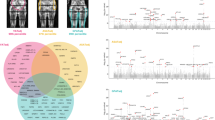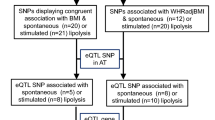Abstract
OBJECTIVE:
Adipose tissue distribution (visceral vs subcutaneous) has been shown to be an important predictor of insulin resistance, diabetes and cardiovascular disease, independent of body mass index. The beta-2 adrenergic receptor is a major lipolytic receptor in human fat cells and the gene that codes for this protein is an important candidate gene for measures of adiposity and fat deposition. We examined whether two common polymorphisms in codons 16 (Arg16Gly) and 27 (Gln27Glu) are associated with measures of fat distribution in participants of the IRAS Family Study.
METHODS:
We recruited African-American (AA) and Hispanic-American (HA) families from Los Angeles, CA, USA (18 pedigrees, 272 AA individuals), San Antonio, TX, USA (33 pedigrees, 448 HA individuals) and San Luis Valley, CO, USA (12 pedigrees, 272 HA individuals). We estimated adipose tissue distribution via computed tomography. To test for an association between adiposity measures and these polymorphisms, we used generalized estimating equations, adjusting for age, gender, clinical site (ethnicity), body mass index, and familial correlation.
RESULTS:
Of the 992 individuals genotyped for these polymorphisms, 57% were female and 15% had been diagnosed with type 2 diabetes mellitus. The mean age was 42.7±14.6 y. The Glu27 allele of the Gln27Glu polymorphism was positively associated with (P-value for recessive model): body mass index (0.025), visceral adipose tissue (<0.0001) and visceral-to-subcutaneous adipose ratio (0.009), but not with subcutaneous adipose tissue (0.952). The Arg16Gly polymorphism was not associated with any of the adiposity measures.
CONCLUSIONS:
These findings suggest that genetic variation in the beta-2 adrenergic receptor gene influences fat deposition and body size in AAs and HAs. In particular, these results support a role for the gene in the distribution of visceral adipose tissue but not subcutaneous adipose tissue.
This is a preview of subscription content, access via your institution
Access options
Subscribe to this journal
Receive 12 print issues and online access
$259.00 per year
only $21.58 per issue
Buy this article
- Purchase on Springer Link
- Instant access to full article PDF
Prices may be subject to local taxes which are calculated during checkout
Similar content being viewed by others
References
Larsson B, Svardsudd K, Welin L, Wilhelmsen L, Bjorntorp P, Tibblin G . Abdominal adipose tissue distribution, obesity, and risk of cardiovascular disease and death: 13 year follow up of participants in the study of men born in 1913. BMJ 1984; 288: 1401–1404.
Prineas RJ, Folsom AR, Kaye SA . Central adiposity and increased risk of coronary artery disease mortality in older women. Ann Epidemiol 1993; 3: 35–41.
Visscher TL, Seidell JC, Molarius A, van der Kuip D, Hofman A, Witteman JC . A comparison of body mass index, waist-hip ratio and waist circumference as predictors of all-cause mortality among the elderly: the Rotterdam study. Int J Obes Relat Metab Disord 2001; 25: 1730–1735.
Oppert JM, Charles MA, Thibult N, Guy-Grand B, Eschwege E, Ducimetiere P . Anthropometric estimates of muscle and fat mass in relation to cardiac and cancer mortality in men: the Paris Prospective Study. Am J Clin Nutr 2002; 75: 1107–1113.
Bjorntorp P . Abdominal fat distribution and the metabolic syndrome. J Cardiovasc Pharmacol 1992; 20 (Suppl 8): S26–S28.
Kaplan NM . The deadly quartet: upper body obesity, glucose intolerance, hypertriglyceridemia and hypertension. Arch Intern Med 1989; 149: 1514–1520.
Rice T, Despres JP, Daw EW, Gagnon J, Borecki IB, Perusse L, Leon AS, Skinner JS, Wilmore JH, Rao DC, Bouchard C . Familial resemblance for abdominal visceral fat: the HERITAGE family study, 1997; 21: 1024–1031.
Langefeld CD, Zaccaro DJ, Scherzinger AL, Norris MJ, Saad MF, Haffner SM, Wagenknecht LE, Rich SS . Familiality of visceral and subcutaneous fat. Diabetes 2001; 50 (Suppl 2): A241.
Kissebah AH, Krakower GR . Regional adiposity and morbidity. Physiol Rev 1994; 74: 761–811.
Liggett SB . Molecular and genetic basis of β2-adrenergic receptor function. J Allergy Clin Immunol 1999; 104: S42–S46.
Large V, Hellstrom L, Reynisdottir S, Lonnqvist F, Eriksson P, Lannfelt L, Arner P . Human beta-2 adrenoceptor gene polymorphisms are highly frequent in obesity and associate with altered adipocyte beta-2 adrenoceptor function. J Clin Invest 1997; 100: 3005–3013.
Garenc C, Perusse L, Chagnon YC, Rankinen T, Gagnon J, Borecki IB, Leon AS, Skinner JS, Wilmore JH, Rao DC, Bouchard C . Effects of β2-adrenergic receptor gene variants on adiposity: the HERITAGE Family Study. Obes Res 2003; 11: 612–618.
Corbalán MS, Marti A, Forga L, Martínez-González MA, Martínez JA . β2-adrenergic receptor mutation and abdominal obesity risk: effect modification by gender and HDL-cholesterol. Eur J Nutr 2002; 41: 114–118.
Hellstrom L, Large V, Reynisdottir S, Wahrenberg H, Arner P . The different effects of a Gln27Glu β2-adrenoceptor gene polymorphism on obesity in males and in females. J Int Med 1999; 245: 253–259.
Mori Y, Kim-Motoyama H, Ito Y, Katakura T, Yasuda K, Ishiyama-Shigemoto S, Yamada K, Yasuo A, Ohashi Y, Kimura S, Yazaki Y, Kadowaki T . The Gln27Glu β2-adrenergic receptor variant is associated with obesity due to subcutaneous fat accumulation in Japanese men. Biochem Biophys Res Commun 1999; 258: 138–140.
Yamada K, Ishiyama-Shigemoto S, Ichikawa F, Yuan X, Koyanagi A, Koyama W, Nonaka K . Polymorphism in the 5′-leader cistron of the β2-adrenergic receptor gene associated with obesity and type 2 diabetes. J Clin Endocrinol Metab 1999; 84: 1754–1757.
Bengtsson K, Orho-Melander M, Melander O, Lindblad U, Ranstam J, Råstam L, Groop L . 2 adrenergic receptor gene variation and hypertension in subjects with type 2 diabetes. Hypertension 2001; 37: 1303–1308.
Green SA, Turki J, Innis M, Liggett SB . Amino-terminal polymorphisms of the human β2-adrenergic receptor impart distinct agonist-promoted regulatory properties. Biochemistry 1994; 33: 9414–9419.
Bruck H, Leineweber K, Buscher R, Ulrich A, Radke J, Insel PA, Brodde O-E . The Gln27Glu β2-adrenergic receptor polymorphism slows the onset of desensitization of cardiac functional responses in vivo. Pharmacogenetics 2003; 13: 59–66.
Gonzalez Sanchez JL, Proenza AM, Martinez Larrad MT, Ramis JM, Fernandez Perez C, Palou A, Serrano Rios M . The glutamine 27 glutamic acid polymorphism of the β2-adrenoceptor gene is associated with abdominal obesity and greater risk of impaired glucose tolerance in men but not in women: a population-based study in Spain. Clin Endocrinol 2003; 59: 476–481.
Kawamura T, Egusa G, Fumikawa R, Okubo M . Gln27Glu variant of the beta-2 adrenergic receptor gene is not associated with obesity and diabetes in Japanese-Americans. Metabolism 2001; 50: 443–446.
Oberkofler H, Esterbauer H, Hell E, Krempler F, Patsch W . The GLn27Glu polymorphism in the beta2-adrenergic receptor gene is not associated with morbid obesity in Austrian women. Int J Obes Relat Metab Disord 2000; 24: 388–390.
Kortner B, Wolf A, Wendt D, Beiseigel U, Evans D . Lack of association between a human beta-2 adrenoceptor gene polymorphism (gln27glu) and morbid obesity. Int J Obes Relat Metab Disord 1999; 23: 1099–1100.
Echwald SM, Sorensen TI, Tybjaerg-Hansen A, Andersen T, Pedersen O . Gln27Glu variant of the human beta2-adrenoceptor gene is not associated with early-onset obesity in Danish men. Diabetes 1998; 47: 1657–1658.
Castellano M, Rossi F, Giacche M, Perani C, Rivadossi F, Muiesan ML, Salvetti M, Beschi M, Rizzoni D, Agabiti-Rosei E . Beta(2)-adrenergic receptor gene polymorphism, age, and cardiovascular phenotypes. Hypertension 2003; 41: 361–367.
Ukkola O, Tremblay A, Bouchard C . Beta-2 adrenergic receptor variants are associated with subcutaneous fat accumulation in response to long-term overfeeding. Int J Obes Relat Metab Disord 2001; 25: 1604–1608.
Ukkola O, Rankinen T, Rice T, Gagnon J, Leon AS, Skinner JS, Wilmore JH, Rao DC, Bouchard C . Interactions among the β2- and β3-adrenergic receptor genes and total body fat and abdominal fat level in HERITAGE Family Study. Int J Obes Relat Metab Disord 2003; 27: 389–393.
Henkin L, Bergman RN, Bowden DW, Ellsworth DL, Haffner SM, Langefeld CD, Mitchell BD, Norris JM, Rewers M, Saad MF, Stamm E, Wagenknecht LE, Rich SS . Genetic epidemiology of insulin resistance and visceral adiposity: the IRAS Family Study Design and Methods. Ann Epidemiol 2003; 13: 211–217.
Bergman RN, Ider YZ, Bowden CR, Corbelli C . Quantitative estimation of insulin sensitivity. Am J Physiol 1979; 236: E667–77.
Bergman RN, Finegood DT, Ader M . Assessment of insulin sensitivity in vivo. Endocr Rev 1985; 6: 45–86.
Steil GM, Volund A, Kahn SE, Bergman RN . Reduced sample number of calculation of insulin sensitivity and glucose effectiveness from the minimal model. Suitability for use in population studies. Diabetes 1993; 42: 250–256.
Buetow KH, Edmonson M, MacDonald R, Clifford R, Yip P, Kelley J, Little DP, Strausberg R, Koester H, Cantor CR, Braun A . High-throughput development and characterization of a genomewide collection of gene-based single nucleotide polymorphism markers by chip-based matrix-assisted laser desorption/ionization time-of-flight mass spectrometry. Proc Natl Acad Sci 2001; 16: 581–584.
O’Connell JR, Weeks DE . PedCheck: a program for identification of genotype incompatibilities in linkage analysis. Am J Hum Genet 1998; 63: 259–266.
Lewontin RC . An estimate of average heterozygosity in man. Am J Hum Genet 1967; 19: 681–685.
Zeger SL, Liang KY . Longitudinal data analysis for discrete and continuous outcomes. Biometrics 1986; 42: 121–130.
O’Connell JR . Zero-recombinant haplotyping: applications to fine mapping using SNPs. Genet Epidemiol 2000; 19 (Suppl 1): S64–S70.
O’Connell J . PROFILER: A program to compute cumulative probability profiles with applications to pedigree analysis. Am J Hum Genet 2000; 67: A1820.
Wajchenberg BL . Subcutaneous and visceral adipose tissue: their relation to the metabolic syndrome. Endocr Rev 2000; 21: 697–738.
Carey DG . Abdominal obesity. Curr Opin Lipidol 1998; 9: 35–40.
Arner P . Regional differences in protein production by human adipose tissue. Biochem Soc Trans 2001; 29 (Part 2): 72–75.
Arner P . Differences in lipolysis between human subcutaneous and omental adipose tissues. Ann Med 1995; 27: 860–867.
Alessi M, Peiretti F, Morange P, Henry M, Nalbone G, Juhan-Vague I . Production of plasminogen activator inhibitor 1 by human adipose tissue: possible link between visceral fat accumulation and vascular disease. Diabetes 1997; 46: 860–867.
Dusserre E, Moulin P, Vidal H . Differences in mRNA expression of the proteins secreted by the adipocytes in human subcutaneous and visceral adipose tissue. Biochim Biophys Acta 2000; 1500: 88–96.
Montague C, Prins J, Sanders L, Zhang J, Sewter C, Digby J, Byrne J, O’Rahilly S . Depot-related gene expression in human subcutaneous and omental adipocytes. Diabetes 1998; 47: 1384–1390.
Lihn AS, Bruun JM, He G, Pedersen SB, Jensen PF, Richelsen B . Lower expression of adiponectin mRNA in visceral adipose tissue in lean and obese subjects. Mol Cell Endocrinol 2004; 219: 9–15.
Lefebvre A-M, Laville M, Vega N, Riou J, Gaal Lv, Auwerx J, Vidal H . Depot-specific differences in adipose tissue gene expression in lean and obese subjects. Diabetes 1998; 47: 98–103.
Linder K, Arner P, Flores-Morales A, Tollet-Egnell P, Norstedt G . Differentially expressed genes in visceral or subcutaneous adipose tissue of obese men and women. J Lipid Res 2004; 45: 148–154.
Author information
Authors and Affiliations
Corresponding author
Rights and permissions
About this article
Cite this article
Lange, L., Norris, J., Langefeld, C. et al. Association of adipose tissue deposition and beta-2 adrenergic receptor variants: the IRAS family study. Int J Obes 29, 449–457 (2005). https://doi.org/10.1038/sj.ijo.0802883
Received:
Revised:
Accepted:
Published:
Issue Date:
DOI: https://doi.org/10.1038/sj.ijo.0802883
Keywords
This article is cited by
-
Relationship between polymorphisms in beta -2 adrenergic receptor gene and ischemic stroke in North Indian Population: a hospital based case control study
BMC Research Notes (2014)
-
Genetic variation in SH3-domain GRB2-like (endophilin)-interacting protein 1 has a major impact on fat mass
International Journal of Obesity (2012)
-
ADRB2 G–G haplotype associated with breast cancer risk among Hispanic and non-Hispanic white women: interaction with type 2 diabetes and obesity
Cancer Causes & Control (2012)
-
Association of Codon 16 and Codon 27 β2‐Adrenergic Receptor Gene Polymorphisms with Obesity: A Meta‐analysis
Obesity (2008)
-
The search for putative unifying genetic factors for components of the metabolic syndrome
Diabetologia (2008)



